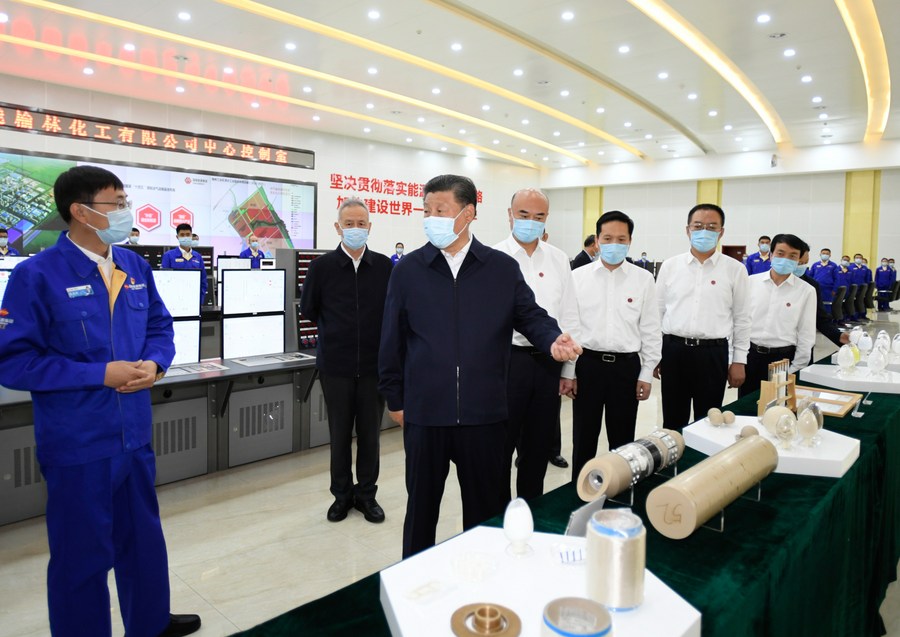China accelerates green shift in energy industry

Chinese President Xi Jinping, also general secretary of the Communist Party of China Central Committee and chairman of the Central Military Commission, learns about the progress in making comprehensive use of coal amid circular economy at a chemical company during his inspection tour of Yulin City, northwest China's Shaanxi Province, Sept. 13, 2021. (Xinhua/Li Xueren)
XI'AN, Sept. 15 (Xinhua) -- Large metal pipes and clusters of towering reaction tanks occupy an under-construction industrial plant in the city of Yulin, a major coal base in northwest China's Shaanxi Province.
It is here that coal, a pollution-intensive raw material, is turned into polyglycolic acid (PGA), a degradable material that can be used to make a variety of products such as disposable tableware, toothbrush, or even surgical suture.
CNH Energy Yulin Chemical Co., Ltd., which owns the plant, is one of many enterprises in the city that recycle coal to reduce its environmental effects as part of efforts to fulfill China's carbon commitment to peak carbon emissions before 2030 and achieve carbon neutrality before 2060.
Chinese President Xi Jinping, also general secretary of the Communist Party of China Central Committee and chairman of the Central Military Commission, stressed efforts to develop the country's energy industry while visiting Yulin on Monday, noting that such development should follow a green and low-carbon path.
Such efforts would be conducive to peaking carbon dioxide emissions and achieving carbon neutrality without straining resources, energy and environmental capacity, he said.
China is the world's largest producer and consumer of energy. According to the country's outline of the 14th Five-Year Plan (2021-2025) and the long-range objectives through the year 2035, China will promote the clean, low-carbon, safe and efficient use of energy, accelerate the development of new energy and environmental protection industries, and promote the overall green shift of economic and social development.
Yulin is at the forefront of the transformation. In the PGA plant, it is estimated that 50,000 tonnes of PGA will be churned out annually by utilizing the coal mined in the city.
Around 517 million tonnes of raw coal was produced in Yulin in 2020, accounting for about 13.2 percent of the national total, local statistics showed. About 27 percent of the coal is used locally.
"Modern coal-based chemical industry should accelerate their green and low-carbon shift," said Zhang Xiansong, chairman of CNH Energy Yulin Chemical Co., Ltd., adding that the industry chain should pursue high-end diversified development for meeting market needs and producing environmentally-friendly products.
The company plans to work with scientific institutions, including the Chinese Academy of Sciences, to apply relevant research outcomes to industrial production for the green shift.
Li Chunlin, Party chief of Yulin, noted that the city is working to cut carbon emissions in the entire coal-based chemical industry chain by using power generated through renewable energy.
In Yulin, the installed capacity of wind and photovoltaic power generation has reached 11.13 million kilowatts. It is expected to hit 37 million kilowatts by the end of 2025, according to local authorities.
In line with China's green drive, more and more enterprises in Yulin are adopting carbon capture and storage as well as improved chemical procedures to reduce emissions.
In Shaanxi Guohua Jinjie Energy Co., Ltd., two large silver tanks are used to store carbon dioxide recycled from a local thermal power plant. It is one of the largest carbon capture utilization and storage projects nationwide.
The equipment, which was put into trial operation on June 25 this year, has captured and produced more than 6,000 tonnes of industrial-level liquid carbon dioxide, which can be further reused, company data showed.
According to a white paper on China's energy development published last year, the country has taken measures to promote green energy production and consumption, optimize the structure of energy production and consumption, accelerate the proportion of clean energy and non-fossil energy consumption, and significantly reduce the intensity of carbon dioxide emissions and pollutant emission levels.
In 2019, coal consumption accounted for 57.7 percent of total energy consumption, down 10.8 percentage points from 2012, while clean energy like natural gas, hydropower, nuclear power, and wind power accounted for 23.4 percent of the total consumption, up 8.9 percentage points over 2012, the paper showed.
Another Yulin-based company, Shaanxi Yanchang Coal Yulin Energy and Chemical Co., Ltd., has invested 40 billion yuan to build a plant for utilizing both coal and natural gas for producing methanol and other chemicals in an eco-friendly way.
Such procedures can greatly cut carbon emission compared with the traditional method of only using coal, said Li Wei, general manager of the company.
For each tonne of methanol produced, the water consumption reduces by 70 percent, and the emissions of carbon dioxide, offscum, and sulfur dioxide come down by 60.38 percent, 61 percent and 59 percent respectively.
"Company profit has also increased with the improved energy utilization efficiency," Li said.
Photos
Related Stories
Copyright © 2021 People's Daily Online. All Rights Reserved.










